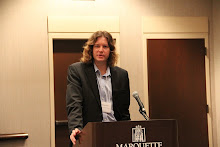In 1935 Heidegger taught the lecture course "Introduction to Metaphysics". In it he included a discussion of a chorus from the second act of Sophocles' Antigone and his own translation of this chorus. Heidegger had prepared, however, two different translations of the chorus. I find it absolutely fascinating that the tensions, and I would say mistakes, with which Heidegger was struggling in this terrible period are captured in the vast distance between the translations of the opening lines of the chorus. Here are the two translations in English, taken from a footnote in Letters 1925-1975: Hannah Arendt and Martin Heidegger edited by Ursula Ludz and translated by Andrew Shields:
"Manifold uncanniness reigns/ and nothing uncannier than man"
"Manifold the uncanny, nothing but / above and beyond man something more uncanny moves itself, moving"
The first translation is also the one which appears in Heidegger's later book version of the course Introduction to Metaphysics as translated by Gregory Fried and Richard Polt.
Clearly the tension between these translations rests in the question of whether there is anything uncannier than man beyond him, or whether man is what is ultimately uncanny. The first translation is consistent with the view, offered by Heidegger in Introduction to Metaphysics, that humanity is uncanny in two senses. First, it finds itself within an overpowering force (the Abiding Sway) which is other than it and determines it and, second, it is capable of a contradictory violence in the face of the abiding sway which pushes back against this determination and allows humanity to go beyond the boundaries of what is determined by nature and, perhaps, history. This also goes hand in hand with a focus on the power of individual poets, thinkers and political leaders as manifestations of the violent force of humanity which can push back against the abiding sway.
The second translation, I would argue, hearkens back to Being and Time and Heidegger's pre-Being and Time commitments as well as forward to the final published version of The Origin of the Work of Art. First, human possibilities are always the possibilities opened up by human history and language such that we can attempt to get a clearer and more honest grasp on history and language so that that we may more authentically understand it and take it up but we can never do anything like "push back" against it except insofar as history itself offers us, on its own accord, a new beginning. Second, specific individual humans do not represent an essential element of the struggle, strife or violence through which history develops and changes but rather it is the world and earth, the unconcealed and concealed of a cultural context, which are engaged in a play or strife within which any given history moment, individual, or people is constituted. Art can change worlds, but art understood as a larger historical event which alone makes possible the existence of individual art works or artists. In short, the first translation is individualist and decisionist while the second is historicist and anti-humanist. It is this first translation, I would claim, that is in sharp tension with Heidegger's work before and after the terrible period of the early and mid-1930s.
Subscribe to:
Post Comments (Atom)


No comments:
Post a Comment